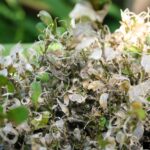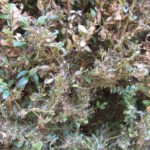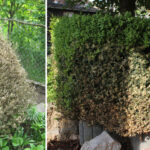What happened
Now is an important time to take a close look at your boxwoods. Plants infested with the invasive box tree moth (Cydalima perspectalis) may have been accidentally transported into Indiana. This moth is native to Asia and has long been the scourge of boxwoods (Buxus sp.) in Europe. It was first detected in North America in Canada in 2018. It has not been found in Indiana yet but due to recent potential introductions in nearby states heavy monitoring is underway. Any suspected sightings of box tree moth should be reported (1-866-NO EXOTIC (1-866-663-9684) or DEPP@dnr.in.gov) so that this destructive pest can be contained before it spreads.
Why it’s a problem
The box tree moth causes serious defoliation to box woods (Buxus sp.) and may also eat burning bush and holly. The caterpillars feed on the bottom layer of leaves when they are small leaving behind a thin, papery membrane (figure 1). When they grow larger, they consume all of the leaf except for the midvein (figure 2). The caterpillars spin webbing in the foliage of the bushes they are feeding on (figures 3). Box tree moth can have anywhere from 1-5 generations per year depending on the climate, opening the potential for multiple defoliation events per season. Their lack of predators combined with their voracious appetite means that they can cause serious damage to the bushes they infest (image 4).
What to watch for
The box tree moth itself can be difficult to identify. The adult moth is easily confused with harmless native moths. The caterpillar stage of the moth is bright green and yellow, but it can be hard to spot because of its small size (~2 cm long). It is easier to spot signs of the caterpillars feeding. Heavy defoliation is unusual in boxwoods and may be a sign of the presence of box tree moths. Although other arthropods (e.g., spiders) construct webbing on boxwoods, webbing combined with leaf damage strongly points to the presence of box tree moth. All instances of boxwoods, burning bush, or holly with heavy defoliation or webbing should be reported to the Department of Natural Resources (1-866-NO EXOTIC (1-866-663-9684) or DEPP@dnr.in.gov).
Additional Resources
- Damage done by small box tree moth caterpillars. Note the thin membranes left in the place of leaves. Image by Ferenc Lakatos, University of Sopron, Bugwood.org
- Damage done by larger box tree moths. Note that all that is left of the leaves is the midvein. Image by Ferenc Lakatos, University of Sopron, Bugwood.org
- The box tree moth caterpillars build webbing in bushes they feed on. These webs might be mistaken for spiderwebs but notice how they closely hug the twigs rather than forming a net between the twigs as might be expected from a spider. Image by AtelierMonpli.
- Two examples of extensive damage to boxwoods from box tree moth. Notice that unlike more common types of defoliation where the twigs are left bare, here the dead parts of the leaves remain mostly on the plant. This is due to a combination of the nature of the damage and the webbing holding the dead leaves in place. Images by I. Sáček, senior and Hungchaka.



